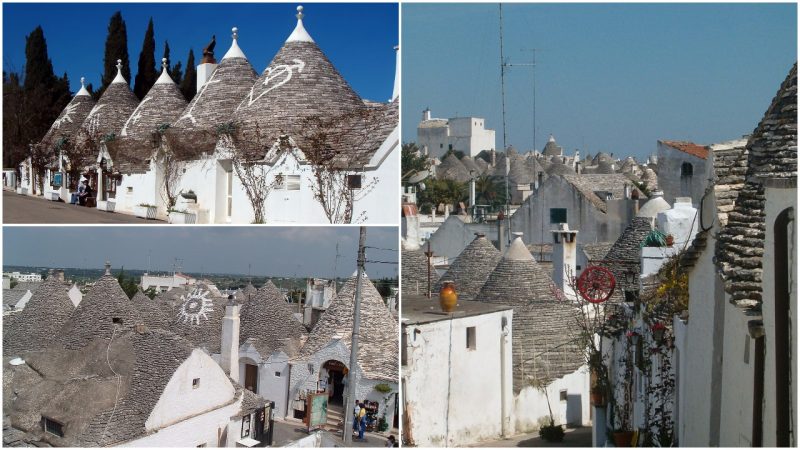A trullo is a small, conical stone hut that was traditionally constructed in the Italian region of Apulia. The remarkable houses were built with the dry-stone technique, which has been used since Neolithic times. That was how people built structures from stones without any cement or mortar to bind the stones together.
The small town of Alberobello, in the province of Bari, is the most famous example, with the highest concentration of trulli. It has been a UNESCO World Heritage Site since 1996. The trulli have whitewashed walls with white symbols painted on their conical roofs. Most of them are Christian symbols, such as a cross or a heart pierced by an arrow that represents Santa Maria Addolorata, Our Lady of Sorrows. The roof of each trullo is topped by a “pinaccolo,” or pinnacle. Some believe it is an ornament, while others suggest it represents the social status of the trullo’s inhabitants.

The origin of the trullo is unclear, but most scholars agree that the first trulli could have appeared in prehistoric times. Many examples of dry-stone dwellings dating from ancient times are found all over the Mediterranean.
In the 8th century BC, the Greeks colonized Apulia. The tholos tombs that the Greeks used for burial are connected with the origin of the trullo. It is probably from the Greek work tholoi that we get the modern word trullo.
Some of the trulli in the Apulia region date back to the 14th century. The then-unpopulated land was given to Robert d’Anjou, Prince of Taranto and the then-King of Naples, as a reward for his service during the Crusades. After that, the land was inhabited with feudal settlements that later became the modern villages of Aja Piccola and Monti.


In 17th century Italy, the nobility imposed heavy taxes on every permanent residence. Supposedly the peasant families started to build dry-stone homes so that they could dismantle them in a hurry, thereby avoiding paying the taxes. The owner was able to demolish the house at a moment simply by pulling the topmost stone on the cone roof that prevented the roof from caving in. However, most historians don’t agree with this theory and suggest the building technique is a result of the geographical conditions of the area, which is abundant with limestone that could be collected from the land and used as part of these huts.


The inhabitants were mostly peasant families. They built roughly circular or square-shaped trulli. In the center of the trullo was the fireplace, used for heating and cooking. It had thick walls, which kept the trullo cool during the summer and warm in the winter. Families would often share two or three cones, and as the family grew, a new trullo was constructed next to the existing ones. The livestock occupied their own trullo. In 1797, the King of Naples, Ferdinand IV de Bourbon, gave the village the title Royal City.

At the end of the 20th century, local craftsman Guido Antionetta brought new life and purpose to the half-abandoned town. He bought a few dozen abandoned trulli, modernizing and renting them as rustic apartments.
Related story from us: Toda huts: The original homes of the Toda people, an ancient Indian tribe
Many others followed his example and in doing so, they preserved the last of the area’s unique trulli and made Alberobello a popular tourist destination. Today, these tiny trulli houses, besides being apartments, also serve as restaurants, a museum, and even a church.
